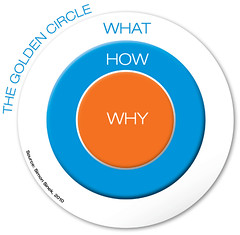I often associate TED Talks with that of the “blast learner”. Blast learners are the types of people who are constantly on the go. They make every single second of their lives count – which might mean not having enough time to sit down and read a whole book. They’re masters of multitasking and inhaling information. TED Talks are perfect for blast learners – their mantra being: feed me great ideas in bursts, and if I need more, I’ll keep diving.
We all have those phases. A few months ago, I was in a blast learning phase because I was trying to get some paintings done for an exhibition in Louisville, KY. Imagine my surprise when I stumble upon a TED Talk called “Start With Why”. I wasn’t prepared at the time, but it reshaped the way I think.
Simon Sinek created a sticky idea. It’s an idea that most people forget, but it is taught in schools. It’s the idea that every grade school teacher you’ve ever had has tried to behoove you to answer. It’s what college professors were trying to ingrain in our heads. Even our parents – no matter how young or old – compel us to struggle with this. Marketers and business gurus across the world are taught this idea. Artists also fight to understand it and best use it in their own artistic theories. It’s to start with why.
 Sinek starts with the Golden Circle. He says that everyone knows what they do. “I build computers.” “I paint portraits.” “I collect pink ceramic rabbits.” You know exactly how you do it. “I buy the parts. I put these parts together, and it makes a computer.” “I get my materials and a model and I create.” “I constantly scan TV shop networks and I visit thrift stores.” But not many people know why.
Sinek starts with the Golden Circle. He says that everyone knows what they do. “I build computers.” “I paint portraits.” “I collect pink ceramic rabbits.” You know exactly how you do it. “I buy the parts. I put these parts together, and it makes a computer.” “I get my materials and a model and I create.” “I constantly scan TV shop networks and I visit thrift stores.” But not many people know why.
Why do you do what do? It’s the simplest question. Why?
I don’t have children, but I know of the “why” stage. It seems like all your child can say is, “But why?” Our instinct is to rush the child through the question to pressure them to stop asking it. Many children grow up to never ask that question ever again. The people who grew up to keep asking it (even almost annoyingly so) are usually the leaders.
Sinek uses Martin Luther King Jr., Apple, Dell, and the Wright brothers as examples. If you haven’t watched the video by now, you should take a moment and give it a watch. Starting with why means giving what you do validation. Giving it validation then drives passion, and once others learn your “why”, they begin to support your passion too. Even if it’s just a verbal endorsement or clicking the Like button, people are attracted to fervor and visionary work. Sinek consistently makes this point.
It’s the message that professors try to hammer into their students. Start with why.
Sinek also points out that while the majority of the world moves from the outside of the Golden Circle to the center, their values, goals, strategies become lost. The organizations and people, however, who move from the inside of the circle to the outermost ring are the ones who become the leaders. Their messages drive action unlike those who start with what.
Consider your own life. Your choices. Now ask, why? If answering it intimidates you, then you’re doing it right. It should be at least a little uncomfortable. For those who already know, keep asking it everyday! Your “why” might sneak up on you and change.
Simon Sinek has a book – called Start With Why. Surprise? Also check out his website. He’s constantly up to something.
